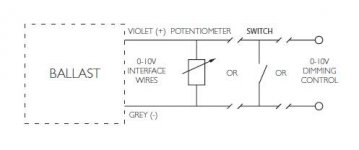Beta Test Team
Member
Is that post to me or rives?
If it's to me, I don't know enough about that to know if I like it or not. I really don't know jack about electronics. I rely on people I trust to tell me if something fits my needs.
But from what I can tell (and I may be wrong), it doesn't suite my needs because I want to be able to choose what % I dim to in an easy way. So for example, I want to push a button or turn a knob to a specific % dim, like choose 50%, 60%, 70%, etc. Because if I know the % I dim to I know the PPF at canopy because the PPF at 100% is very well defined (at any height from the floor between the bottom and top irradiance planes) using Greenbeams modeled by LTIOptics.
For example, if I dim to 70% I know the PPF at canopy (at any point between the two irradiance planes) without measuring with my quantum sensors, so I know the DLI as well. However, if I just dim without knowing the % of total energy I'm dimming to, I need to test with my quantum sensors to know the PPF and DLI.
If it's to me, I don't know enough about that to know if I like it or not. I really don't know jack about electronics. I rely on people I trust to tell me if something fits my needs.
But from what I can tell (and I may be wrong), it doesn't suite my needs because I want to be able to choose what % I dim to in an easy way. So for example, I want to push a button or turn a knob to a specific % dim, like choose 50%, 60%, 70%, etc. Because if I know the % I dim to I know the PPF at canopy because the PPF at 100% is very well defined (at any height from the floor between the bottom and top irradiance planes) using Greenbeams modeled by LTIOptics.
For example, if I dim to 70% I know the PPF at canopy (at any point between the two irradiance planes) without measuring with my quantum sensors, so I know the DLI as well. However, if I just dim without knowing the % of total energy I'm dimming to, I need to test with my quantum sensors to know the PPF and DLI.
Last edited:

 you do good work here.
you do good work here.


